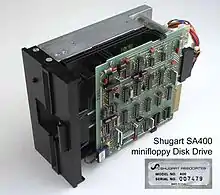Shugart Associates
Shugart Associates (later Shugart Corporation) was a computer peripheral manufacturer that dominated the floppy disk drive market in the late 1970s and is famous for introducing the 5 1⁄4-inch "Minifloppy" floppy disk drive. In 1979 it was one of the first companies to introduce a hard disk drive form factor compatible with a floppy disk drive, the SA1000 form factor compatible with the 8-inch floppy drive form factor.
| Industry | Computer hardware |
|---|---|
| Founded | 1973 |
Area served | Worldwide |
Key people | Alan Shugart (Founder) |
| Products | Floppy disk drives Hard disk drives |
Founded in 1973, Shugart Associates was purchased in 1977 by Xerox, which then exited the business in 1985 and 1986, selling the brand name and the 8-inch floppy product line (in March 1986) to Narlinger Group, which ultimately ceased operations circa 1991.
History
Beginnings
Alan Shugart, after a distinguished career at IBM and a few years at Memorex, decided to strike out on his own in 1973; after gathering venture capital, he started Shugart Associates. The original business plan was to build a small-business system (similar to the IBM 3740[1]) dealing with the development of various major components, including floppy disk drives and printers. After two years, Shugart had exhausted his startup money and had no product to show for it. The board then wanted to focus on the floppy disk drive, but Shugart wished to continue the original plan. Official company documents state that Shugart quit, but he himself claims that he was fired by the venture capitalists. Shugart went on with Finis Conner to found Shugart Technology in 1979, which was later renamed to Seagate Technology in response to a legal challenge by Xerox.

The 5 1⁄4-inch floppy disk drive was introduced by Shugart in September 1976 as the Shugart SA-400 Minifloppy (Shugart's trademarked brand name)[2] at an OEM price of $390 for the drive and $45 for ten diskettes.[3] The SA-400 and related models became the company's best selling products, with shipments of up to 4000 drives per day.
The original SA-400 was single-sided and supported 35-track formatting. It could be used on either hard- or soft-sector floppy controllers and was rated at 85 kB (with a single-density controller) or 110 kB (with a double-density controller). The drive became the basis of the disk system on the Radio Shack TRS-80 Model I, Apple II, and many other early microcomputers.
Late 1970s
Xerox announced acquisition of Shugart Associates in August 1977 and completed its purchase that December at a price of about $41 million.[4]
In 1979, Shugart Associates introduced the "Shugart Associates System Interface" (SASI) to the computing world; the interface subsequently evolved into SCSI (Small Computer System Interface). The first standard process completed in 1986 with ANSI standard X3.131-1986 (popularly known as SCSI-1) as the result. Larry Boucher led the SASI engineering team; he and several of the engineers who worked on SASI left in 1981 to found host adapter maker Adaptec.
Also in 1979, Shugart Associates introduced the SA-1000, a series of hard disk drives that kept as many mechanical, electrical and formatting similarities as possible with its floppy-drive counterparts. Their physical dimensions, including mounting holes, were the same as an 8-inch floppy drive, making them some of the earliest hard drives compatible with a floppy drive form factor.[5] By 1983, Shugart Associates had shipped over 100,000 such drives.
1980s
In the early 1980s, in order to avoid development and start-up costs, the company turned to Matsushita Communications Inc., a subsidiary of Panasonic Corporation (then known as Matsushita Electric Industrial Co., Ltd), for its half-height 5 1⁄4-inch drives, sending that company on its way to becoming the largest floppy drive manufacturer in the world. In 1985, in order to resolve an inventory accumulation and as part of its exit strategy, Xerox gave up Shugart's exclusive rights to the Matsushita half-height 5 1⁄4-inch floppy drives. Shugart's eventual downfall came about partially as a result of the company failing to develop a reliable 80-track disk drive.
In 1983 the company changed its name to Shugart Corporation.
Shugart's operating losses in 1984 along with Xerox's own troubles led Xerox to conclude in 1985 that Shugart businesses were no longer strategically important, resulting in a decision to close down Shugart rather than invest in recovery.[4] Most of Shugart's businesses were shut down afterwards; however its floppy disk drive business was sold in March 1986 to Narlinger, which promptly rebranded itself as Shugart Corporation[6] Under the management of Narlinger, Shugart acquired several discontinued product lines such as Tandon's 8-inch floppy drives (1986) and the Optotech 5984 Write Once Read Many (WORM) drive (1988). It ceased operations around 1991.
See also
References
- IBM 3740 IBM Archives
- Sollman, G. Evolution of the minifloppy (TM) product family IEEE Transactions on Magnetics, Jul 1978.
- Shugart Adds Minifloppy Drive, Computerworld, Sept 13, 1976, p. 51.
- BARBASH, SHEPARD (January 17, 1985). "Xerox to Close Its Shugart Disk-Drive Manufacturer". LA Times. Retrieved December 19, 2017.
- Yencharis, Len (September 13, 1979). "Winchester technology invades floppy territory with low-cost 8-in. drive". Electronic Design: 70, 71 & 75.
- Nee, Eric (March 10, 1986). "Xerox Sells Rest Of Shugart; Sets Drive Opns. Date". Electronic News: 17.
External links
| Wikimedia Commons has media related to Shugart Minifloppy. |
